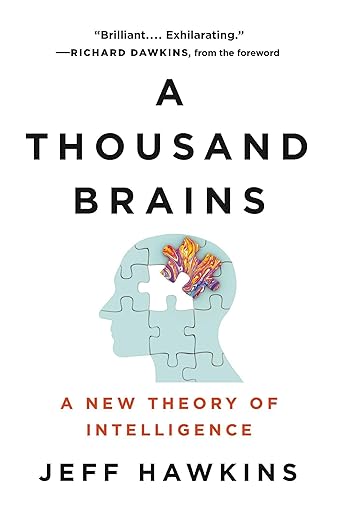At A Glance
Title: A Thousand Brains: A New Theory of Intelligence
Target Audience: Businesspeople, technologists, and enthusiasts in the field of Artificial Intelligence and Neuroscience
Topic: New perspectives on brain function and intelligence, impacts on Artificial Intelligence, strategic decision-making, and digital transformation

- Author: Jeff Hawkins
- Language: English
- Pages: 288
- Price: About 12 Euros (Kindle Edition) | About 30 Euros (Hardcover)
- Positive: Offers groundbreaking insights into intelligence, has significant impacts on AI in the business sector, promotes understanding of human intelligence for strategy development
- Negative: May require basic knowledge in neuroscience or technology for full understanding
- Buy: Amazon
In Detail
“A Thousand Brains: A New Theory of Intelligence” by Jeff Hawkins offers a groundbreaking perspective on how the brain works and its implications for Artificial Intelligence (AI), strategic decision-making, and the future of digital transformation.
Hawkins, a technologist and neuroscientist, presents a new theory of intelligence based on the neocortex, the part of the brain responsible for higher cognitive functions such as perception, analysis, rational behavior, consciousness, and abstract thinking. His thesis revolves around the “Theory of a Thousand Brains”, which suggests that the neocortex consists of numerous identical structures called “reference frames” that process sensory information to model everything we know, not just physical objects.
This theory significantly deviates from current AI paradigms and emphasizes the need for a universal principle of adaptability in true intelligence – a feature currently lacking in AI. Hawkins suggests that the brain’s ability to adapt to any task and constantly update its predictions based on sensory inputs is a fundamental aspect of intelligence, differentiating it from the single-purpose function of current AI systems.
Hawkins’ insights into the neocortex and its role in intelligence have far-reaching implications for business strategy and innovation. In a data-driven business environment, adaptability and the ability to integrate diverse streams of information are crucial. Hawkins’ theory suggests that developing AI systems with neocortex-like adaptability could revolutionize decision-making, strategic planning, and problem-solving in business contexts.
Furthermore, the book highlights the difference between the neocortex and the more primitive parts of the brain, emphasizing the importance of rational, logical thinking over instinctive behavior. This distinction is crucial for businesses looking to surpass traditional models and adopt a data-driven, innovative approach. By understanding the mechanisms of human intelligence, businesses can better design AI systems that complement human decision-making rather than replicating our instinctive biases.
In summary, “A Thousand Brains” provides a compelling framework for understanding intelligence, with significant implications for the future of AI and its application in the business sector. Hawkins’ theory underscores the importance of adaptability, integration of various information streams, and rational decision-making – all critical elements for businesses transforming into data-driven enterprises. This book is not just a theoretical exploration but a guide for businesses looking to navigate the complexities of the digital age with innovative, intelligent strategies.
